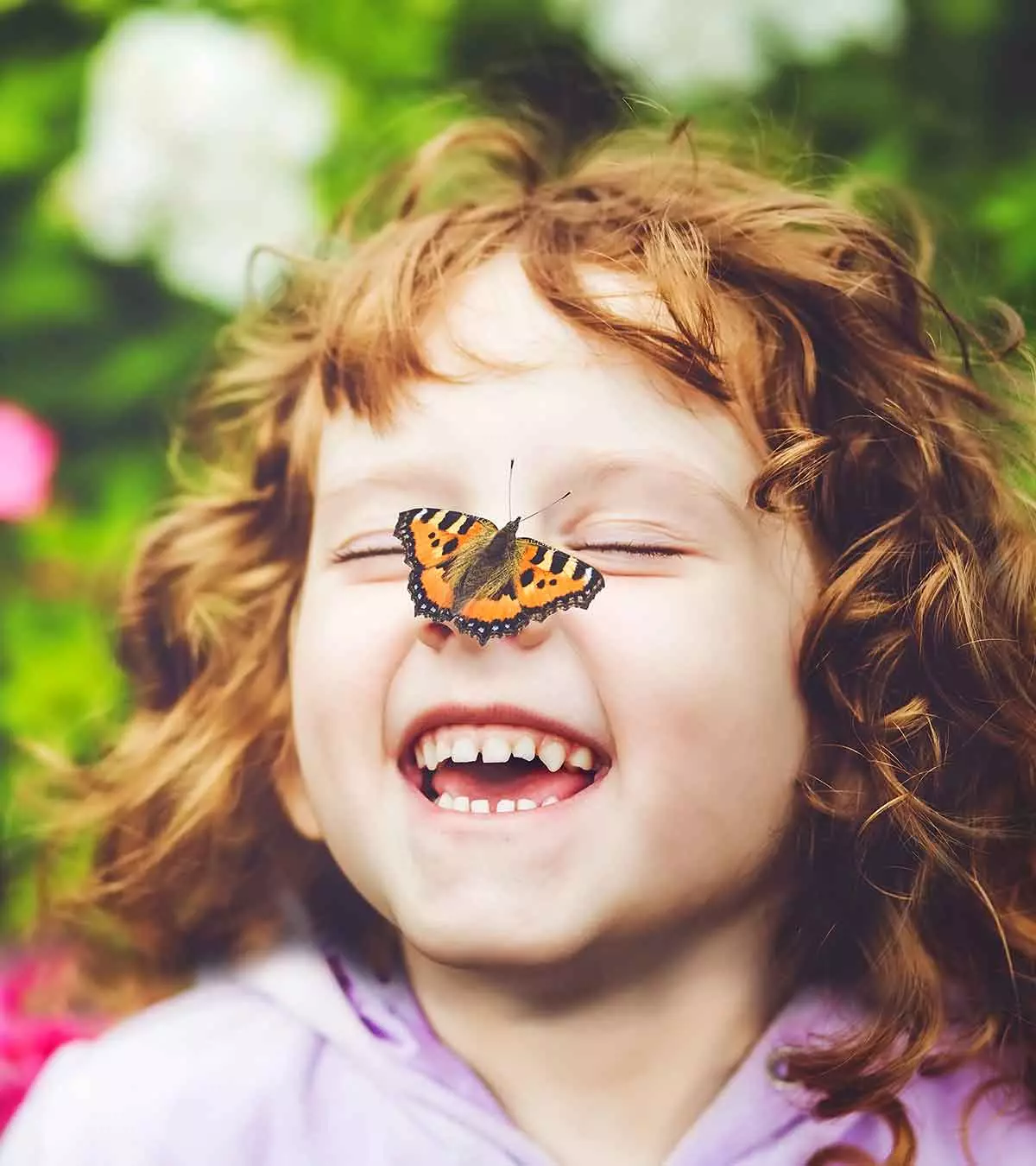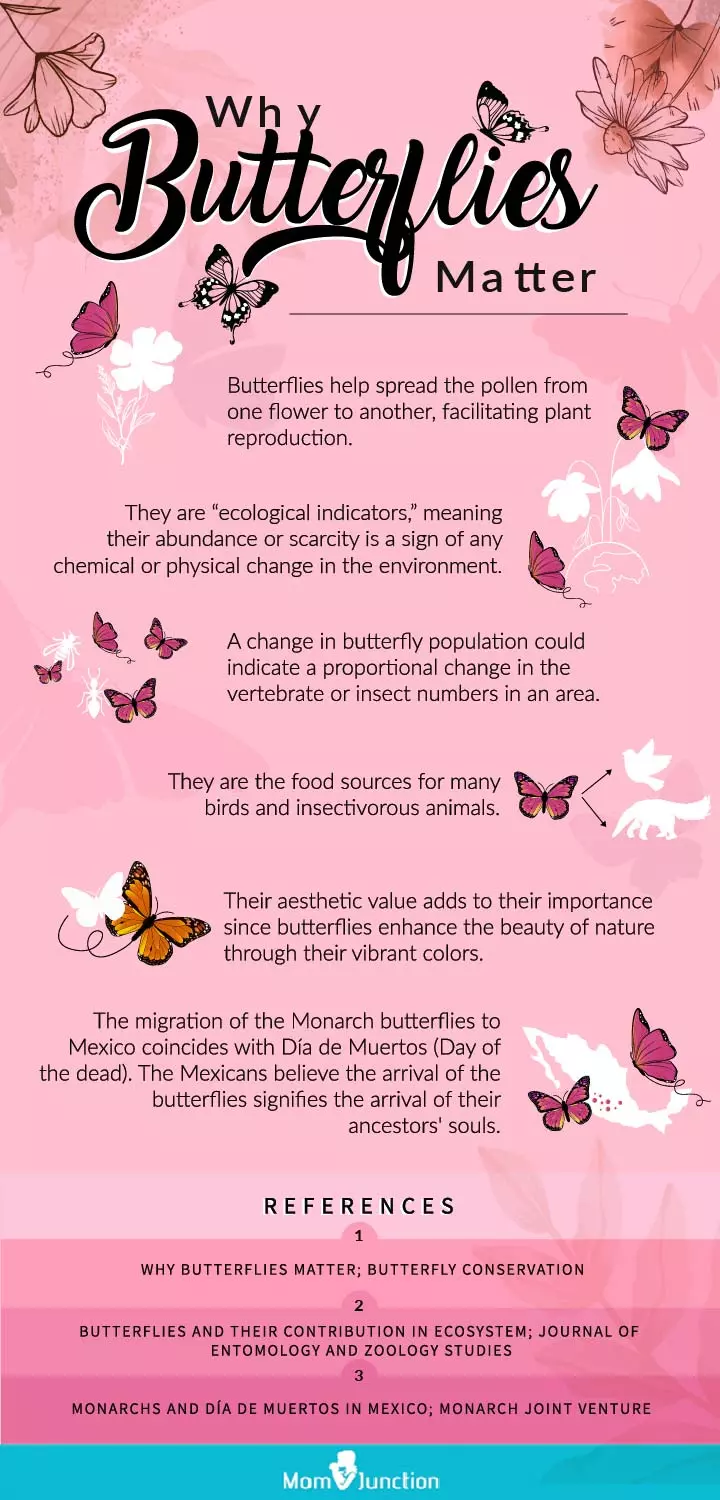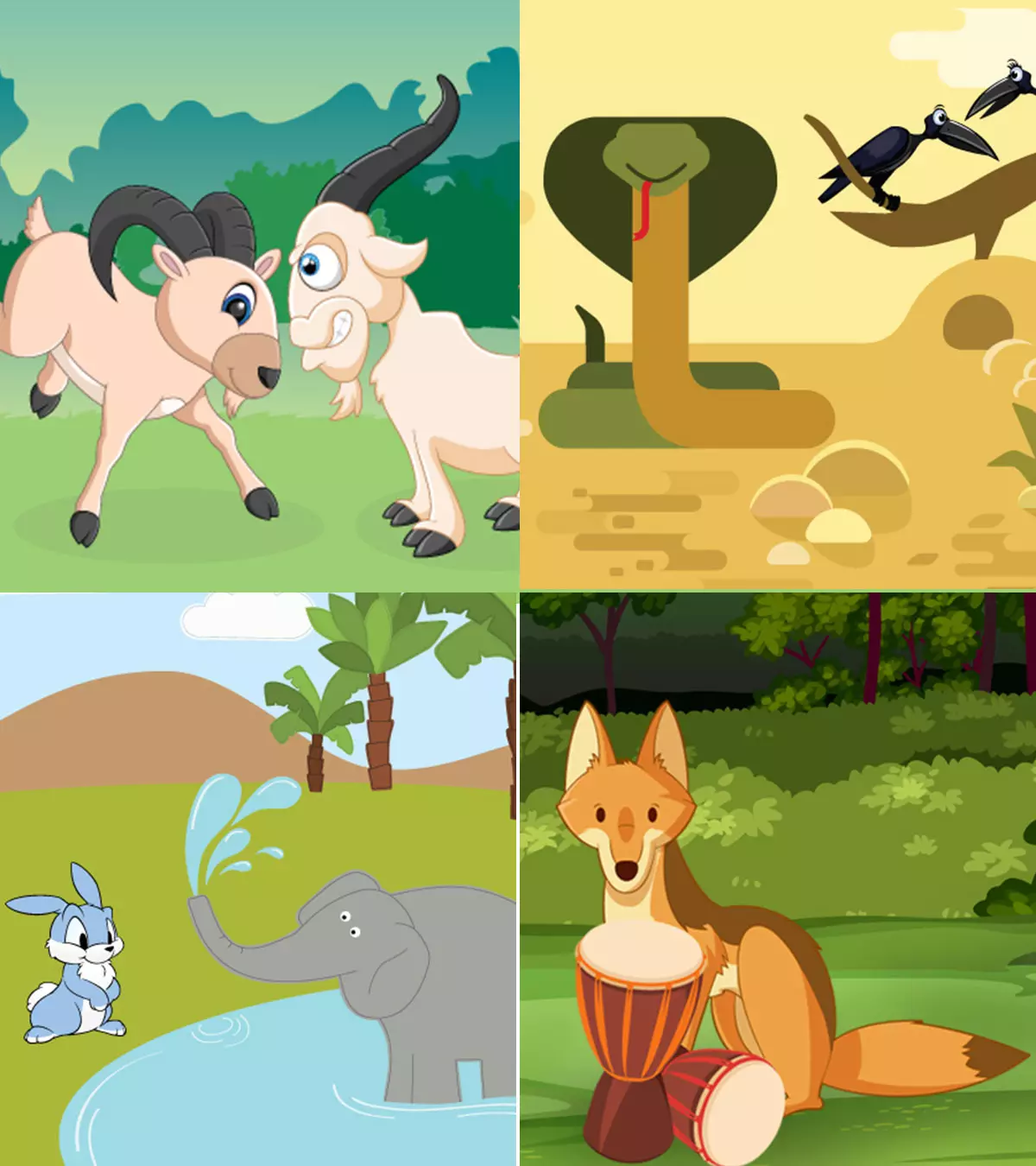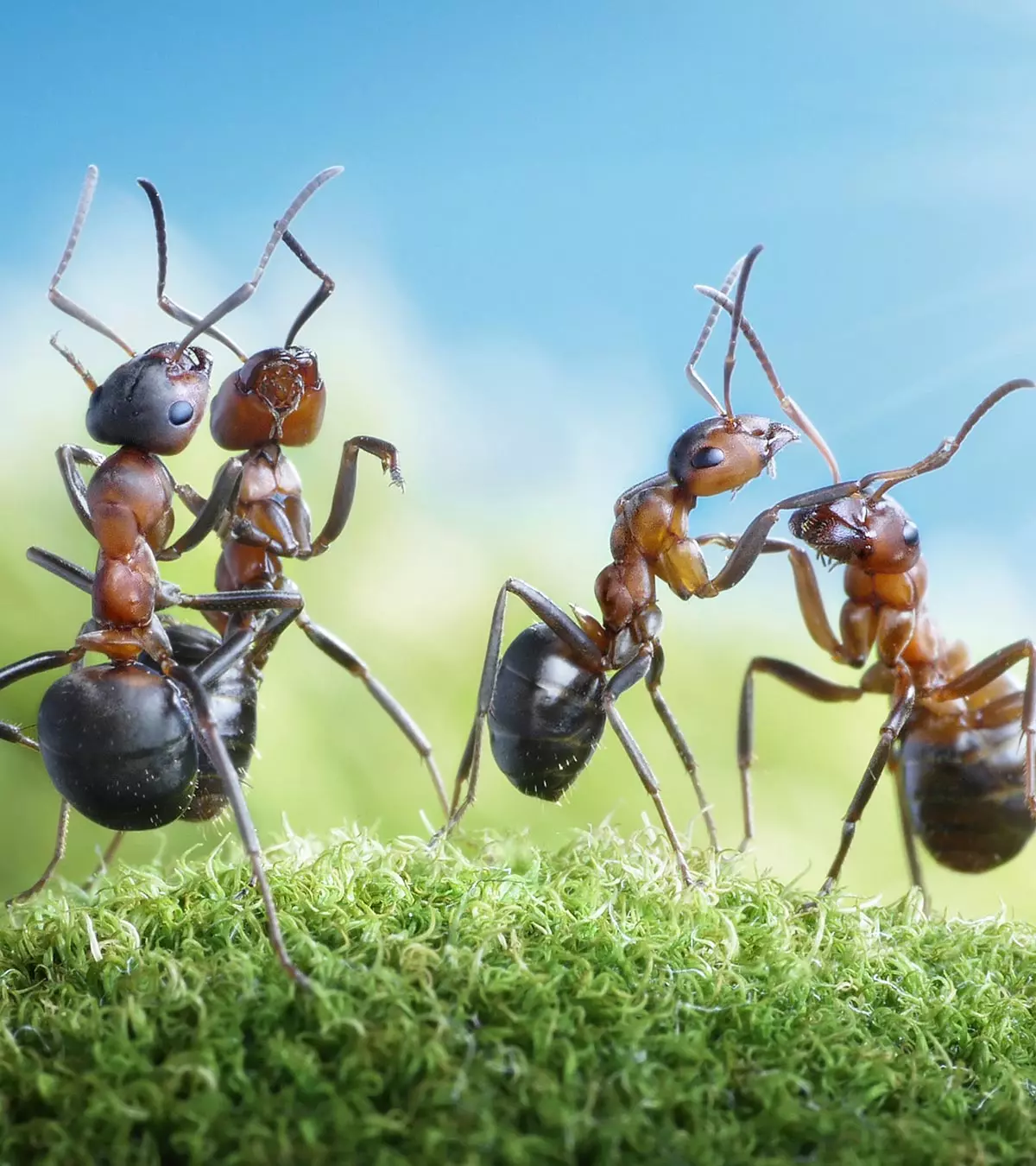
Image: ShutterStock
Is your child someone who is extremely fascinated with the vibrant colors of a butterfly? Well, we’re here to tell you that there are plenty of interesting facts about butterflies for kids out there.

If your child squeals with joy when they see a butterfly and has expressed an interest in learning more about this tiny winged insect, there’s a lot you can teach them. Since almost every child has seen a butterfly, we bet they would be highly curious about how the wings function or what the butterfly eats.
In this post, we list some super interesting and fun facts about butterflies. Read on and share some with your children.
Key Pointers
- Butterflies, skippers, and moth butterflies are part of the Papilionoid superfamily.
- Butterflies can be found on all continents except Antarctica and thrive in different habitats.
- A butterfly’s average lifespan ranges from 3 days to 11 months depending on various factors.
- Climate and habitat affect the lifespan of butterflies, with those in captivity living longer than those in the wild.
Classification
Butterflies are a class of insects belonging to the Lepidoptera order. The order comprises the Papilionoid superfamily, along with two smaller groups, the skippers, and the moth-butterflies.
Range
There are around 28000 species of butterflies found on all the continents, except Antarctica. Butterflies feel comfortable in a broad range of habitats, from tropical forests to tundra to grasslands.
How Did The Butterfly Get Its Name?
Do you wonder how the butterfly got its name? The term butterfly was first used to describe the bright yellow male brimstone, a butter colored insect. It eventually came to include the species of the butterfly. Another reference is that butterflies would hover around when the farmers would churn butter.
Anatomy

- Butterflies can range from 1 inch to 11 inches in total size, depending on the species.
- A butterfly has three body parts- head, thorax and the abdomen. The six legs and four wings of the butterfly are attached to the chest. Some butterflies use just four feet, carrying the two front legs against their bodies, just like the peacocks.
- The body of a butterfly is covered with tiny, sensory hairs.
- Butterflies do not have lungs. They breathe through spiracles, the openings in their abdomen.
- Butterflies have two antennae on their head, which they use to feel, hear and smell.
- The butterflies have ultraviolet markings on their wings that help them locate potential mates. Even flowers have ultraviolet markings that signal butterflies to come and use them for pollination.
- Butterflies have exoskeletons, which means skeletons outside the bodies. The exoskeleton protects them and keeps the water inside their bodies so that they don’t dry out.
- Butterflies have a long and flexible tube-like tongue called proboscis that they use for sucking nectar of the flower. The proboscis remains curled under their chin until they find a source of nectar or other liquid nutrition.
Butterfly Life Cycle Facts For Kids

One of the most incredible features of the butterfly is how they transform from crawling caterpillars into winged beautiful. The transformation of a butterfly from caterpillar involves four steps- egg, caterpillar, pupa and adult. This process is known as metamorphosis, coming from the Latin words for “changing shape.”
- A butterfly starts its life as an egg that an adult female butterfly lays her eggs on a plant.
- The egg hatches and a tiny caterpillar (larva) crawl out of the shell. The caterpillar then feeds on the eggshells and the surrounding plants. It is at this stage most of the growth takes place.
- A caterpillar casts its skin five times before becoming a pupa. This is the resting stage in the life of a butterfly. When the caterpillar sheds its last skin, it forms a hard casing called chrysalis around its body. After 10 to 12 days, the chrysalis breaks open, revealing a beautiful butterfly.
- When the butterfly emerges from the chrysalis, it greets the world with wet and crinkled wings wrapped around its body. The butterfly then pumps the body fluid through the wings to expand them. Once the wing reaches its full size, the butterfly rests for a few hours to dry and harden its body to take its first flight.
Lifespan Of A Butterfly
- The lifespan of a butterfly depends on various factors like size, species, location and the time it turns into an adult. For instance, a small-sized butterfly will not live as long as the larger butterflies. However, the average lifespan is somewhere between 3 days and 11 months.
- The tiny butterflies you spot feasting on the flowers in your yard live only for a week. Large butterflies like Mourning Cloaks, Heliconians, and Monarch Butterflies have an average lifespan of nine months. The Brimstone Butterfly has the longest lifetime out of all the adult butterflies. It can live up to 10 months.
- The climate is another factor that determines the lifespan of a butterfly. For example, if the egg is laid just before winter sets in, the little butterfly will stay in it until the weather warms. As the weather warms, the caterpillar will hatch and everything will start again. If the butterfly does not migrate before winter, it will hibernate until the weather warms. This means that a butterfly could live for many months past the average life span.
- The habitat also affects the longevity of the butterfly. Butterflies in captivity can live for around 10 months. The butterflies living in the wild are exposed to many predators like birds and other big insects, so they may not be able to live long enough. And during their life, a butterfly focuses all its energy on just two tasks- eating and mating.
Diet

- When it comes to butterflies, not many people are aware of their diet. So let’s check out a few things that a butterfly likes to eat.
- For starters, caterpillars eat only the leaves of the plants, with different caterpillars liking particular kinds of plants. And their first meal is its own eggshell. The leaves provide caterpillars with all the nutrients they need to transform into a beautiful butterfly. But some caterpillars are also meat eaters. The larva of the Harvester butterfly eats wooly aphidsiSap-sucking insects with soft bodies that puncture plant tissues to extract juices and cover themselves with a white waxy substance .
- Adult butterflies stick to an all-liquid diet because they cannot suck up any solid with their straw-like tongue. They especially love to drink from the slices of watermelon, orange and banana. If you want to attract butterflies to your garden, plant a few fruit and flower bearing trees and soon you’ll have a yard full of butterflies.
- A butterfly cannot live just on the sugar. It needs minerals too. To supplement their diet, a butterfly sips occasionally from the mud puddles, which are rich in salts and minerals. This behavior, which is called pudding, occurs in male butterflies more than the females. The male butterflies incorporate the minerals into their sperm, which are transferred to females during mating.
Butterfly And Flight
Butterflies are insects, even though they may not look like them because of their broad, scaly wings. And they are excellent fliers. They have two pairs of large wings covered with vivid scales. But sadly, butterflies can fly only when the body temperature is above 86 degrees. Being cold-blooded animals, butterflies cannot regulate their body temperature. If the temperature falls below 50 degrees Fahrenheit, the butterflies are rendered immobile. The butterflies can fly easily at temperature ranges between 82 and 100 degree Fahrenheit. On colder days, the butterflies have to warm up their flight muscles by basking in the sun.
The speed of a butterfly varies among the species. The toxic varieties of butterflies are slower than the non-toxic varieties. The fastest a butterfly can fly is 12 miles per hour. Some moths can even fly at 25 miles per hour. This is amazing information about butterflies for kids.
Behavior
- Butterflies have taste receptors on their feet that aid them locate food. A female butterfly drums the leaves with her feet to release the juices. And the spines on the back of her legs have chemoreceptorsiSpecific nerve cells or receptors that detect changes in blood composition that can help them ascertain whether the leaf they are sitting on is good to lay eggs or not. After detecting the right plant, she lays her eggs in it. Butterflies also step on their food and taste the food sources using their sensing organs.
- The colorful wings of the butterflies help them blend with the flowers when they are feeding. The colors also help them attract a mate.
- Butterflies have good eyesight within 10 to 20 feet. Anything beyond this distance can make things blurry to a butterfly. Butterflies rely on their vision for tasks like finding mates of the same species and flower to feed. But they filter a lot of colors. Butterflies can see red, green and yellow colors. In addition to these colors, butterflies can also see a range of ultraviolet rays that are invisible to the eyes of a human being.
- A butterfly that cannot drink nectar is doomed. When the butterfly emerges from the case, its mouth is in half. So the first job of an adult butterfly is to assemble its proboscis the moment it emerges from chrysalis. The butterfly begins working on its mouth using the palpiiTactile organs that emerge from the head or front end of some annelids and mollusks located adjacent to the proboscis.
Butterfly Migration

Like most of the animals, even butterflies migrate. Monarch butterflies undertake a journey of 2000 miles from the Great Lakes to the Gulf of Mexico during winter and return to the north in the spring. There are several reasons why butterflies migrate to other places. Here are a few:
- Butterflies are cold-blooded creatures. They cannot handle the cold weather so they travel to warmer places.
- Butterflies also migrate to establish new colonies. The reason for this is that they cannot stay in a location for too long.
- Also, caterpillars consume all of their food in one area. So migrating to new places will ensure a regular supply of their food source.
How Do Butterflies Avoid Being Eaten?
- Butterflies rank very low on the food chain, so loads of hungry predators wait to make a meal of them. But butterflies are very smart and they employ all sorts of tricks from being eaten by their predators.
- They fold their wings to blend with the surroundings and render themselves invisible to the predators. Other butterflies try exactly the opposite strategy. They wear vibrant colors and patterns on their body that announce their presence boldly.
- Brightly colored butterflies also release toxic or poison when eaten. So the predators prefer to avoid them.
- Some butterflies are not toxic at all, but they imitate the species that are renowned for their toxicity in the animal kingdom. They repel the predators by mimicking their deadly cousins.
Not only are butterflies at risk of being preyed upon, but their survival is also threatened due to human activities such as habitat loss, agriculture, forestry, and housing. The following graph shows the changes in the population of Western Monarch butterflies over the year. As the graph highlights, there’s been a significant decrease in the population, from over a million to 29,418 in the past 20 years.

Declining population of the Western Monarch butterflies
Source: Western Monarchs Declining Rapidly; Statista/Xerces SocietyDo All Caterpillars Turn Into Butterflies?
- No, not all caterpillars turn into butterflies.
- Caterpillars belong to the order Lepidoptera. They are the larval stage of insects that include moths and butterflies. While many caterpillars do eventually transform into butterflies, some become moths instead.
- The life cycle of a butterfly or moth typically consists of four stages: egg, larva or caterpillar, cocoon or pupa, and adult, which is the butterfly or moth.
- The specific species of caterpillar determines whether it will become a butterfly or a moth.
Is A Butterfly An Invertebrate?
- Yes, a butterfly is an invertebrate.
- Invertebrates are animals that lack a vertebral column or backbone. Butterflies, like all insects, fall into the category of invertebrates.
- Instead, they have an exoskeleton that protects their soft inner body, with scales on their wings that protect them from extreme temperatures.
Facts About Butterfly For Kids
- This is one of the most fun and interesting facts about butterflies for kids. Butterfly wings are transparent. But how is that possible as butterflies are the most colorful and vibrant insects around? That’s because a butterfly’s wing is formed by layers of chitin, a protective substance that composes an insect’s exoskeleton. The layers are so thin that we can see right through them. And the thousands of tiny scales covering the transparent chitin reflect the light in different colors. As the butterfly ages, the scales fall off the wings, leaving the chitin layer exposed.
- The representations of butterflies are even seen in the Egyptian frescoesiAn antique tempera painting where water-soluble pigments were applied on a thin layer of plaster at Thebes, which are more than 3500 years old.
- The Case Moth caterpillars, as the name implies, build a case around themselves. The case is made of silk and tiny pieces of plants.
- Female butterflies are larger than males. They even live longer than their male counterparts do.
- Scientists say that the appearance of black bands of the Wooly Bears caterpillar denotes the arrival of winter.
- Most of the butterflies live on the pollen and nectar from the flowers.
- Some of the female species of moth lack wings. All they can do is crawl and move.
- The Morgan’s Sphinx Moth belonging to Madagascar has a proboscis or tube mouth that is around 12 to 14 inches long. They use their tube mouth to suck nectar from the bottom of a 12-inch deep orchid.
- Some moths do not eat anything as adults as they don’t have mouths. They live on energy stored as caterpillars.
- Butterflies cannot see, but they can feel vibrations. This is amazing butterfly information for kids to know.
- Butterflies can fly even if their scales are removed. They just look a bit less colorful.
- The Queen Alexandria’s Birdwing from the New Guinea Island is the largest butterfly in the world. It has a wingspan of around 27cm.
- Australia is home to 385 species of butterfly, nearly 70% of which are found in the Wet Tropics rainforest.
- The Painted Lady is the most commonly found butterfly in the world. It is found all over the world, except Antarctica and South America.
- Some species of butterflies, including Northern Pearly Eye fly at night.
Frequently Asked Questions
1. Why do butterflies like flowers?
Butterflies are attracted to flowers because they provide them with nectar and act as a resting place. Nectar is essential for butterflies because it gives them energy for their flight. Therefore, butterflies like to visit from one flower to another, collecting nectar.
2. How many eyes do butterflies have?
Just like us humans, butterflies also have two eyes. But their eyes are made up of several mini lenses, allowing them to look in different directions simultaneously. Hence, their eyes are also known as compound eyes.
3. Why do butterflies have scales on their wings?
Butterflies have tiny colored scales on their wings that serve different purposes. These scales help butterflies absorb sunlight, fly properly, and blend in with their surroundings. They also give butterflies their beautiful colors and patterns, making them unique and diverse (4).
4. How have human activities, such as deforestation and pollution, impacted butterfly populations?
Human actions like cutting down trees and causing pollution have harmed butterflies. When trees are cut down, the places where butterflies live are destroyed. Pollution can also hurt the things butterflies eat and make it harder for them to grow. This has caused many butterfly species to lose their homes, become fewer in number, and some may even disappear forever.
5. How do butterflies communicate with each other, and what types of signals do they use?
Butterflies talk to each other using their beautiful wings and special scents. They show off their colorful patterns, dance in the air, and release special smells called pheromones to find a partner, protect their territory, and let others know if there’s danger nearby. These signals help butterflies talk and share important messages with each other.
6. How do butterfly populations rebound after natural disasters or other disturbances?
Butterflies can bounce back from natural disasters or disruptions by finding new places to live and settle down. They lay a bunch of eggs, usually between twelve to several hundred, which take about a month to turn into adult butterflies. When there are plenty of suitable homes and enough food to go around, this can help their numbers increase once again.
7. Why should children learn about butterflies?
Butterflies are unique insects that play a significant role in our ecosystem as pollinators, aiding the growth of flowers and plants. They not only represent nature’s beauty but also maintain the food web that sustains other lives. When children learn about butterflies, they can appreciate nature and understand why it is important to conserve it. Butterfly facts can make children curious and develop a responsibility to protect these creatures and their habitats.
Facts about butterflies for kids are a great way to take your child a step closer to science and nature. Butterflies are beautiful little creatures that can be found in many habitats, from tropical rainforests to grasslands. Their life cycle includes stages of egg, crawling caterpillar, pupa to winged butterfly. The lifespan of these beautiful creatures varies depending on the size, location, and species, from a few days to months. Climate and habitat may also influence the lifespan of butterflies. They fold wings to blend and become invisible to predators. So, learn and keep sharing such intriguing facts with children around. You could also engage your children in some fun butterfly coloring pages as you tell them these facts.
Infographic: Why Are Butterflies Important?
Have you ever wondered if there’s more to these beautiful creatures than just their vibrant colors? Use this infographic to learn about the importance of butterflies and share it with your dear ones to appreciate more of their beauty. Illustration: Momjunction Design Team
Illustration: Fun And Fascinating Butterfly Facts For Kids

Image: Stable Diffusion/MomJunction Design Team
Learn all about butterflies in this fun and educational video for kids! Discover their life cycle, habitat, and more!
References
- Why butterflies matter;
https://butterfly-conservation.org/butterflies/why-butterflies-matter - Butterflies and their contribution in ecosystem;
https://www.researchgate.net/publication/299427719_Butterflies_and_their_contribution_in_ecosystem_A_review - Monarchs and Día de Muertos in Mexico;
https://monarchjointventure.org/blog/monarchs-and-dia-de-muertos-in-mexico - Butterfly Scales = Pixie Dust;
https://www.lewisginter.org/pixie-dust-butterfly-scales/ - Butterfly Metamorphosis;
https://www.amnh.org/exhibitions/butterflies/metamorphosis#:~:text=Inside%20the%20skin%20of%20the - Large Populations of Painted Lady Butterflies;
https://cropwatch.unl.edu/2017/large-populations-painted-lady-butterflies/
Community Experiences
Join the conversation and become a part of our nurturing community! Share your stories, experiences, and insights to connect with fellow parents.
Read full bio of Theresa Bertuzzi
Read full bio of Debolina Raja
Read full bio of Harshita Makvana
Read full bio of Kavita Kankani


















